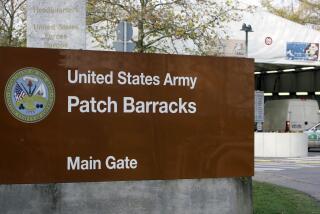U.S. Reveals Color-Coded Terror Warnings
- Share via
WASHINGTON — The government unveiled a new color-coded alert system Tuesday that officials hope will remove some of the confusion about the severity of a terrorist threat.
Tom Ridge, director of the White House Office of Homeland Security, said the system of “graduated threat assessments” should provide the public with clearer warnings about the danger of possible terrorist acts.
Since Sept. 11, the administration has struggled with how to give citizens terrorism warnings that were more than just confusing, such as last fall’s advisory that terrorists might attack the Golden Gate and other California bridges.
The new color-coded warning system attempts to grade a terrorism threat in much the same way that weather forecasters warn of storms, but officials acknowledged their terrorist alerts will be far less scientific.
In Sacramento, Gov. Gray Davis called Ridge’s proposal “a practical, common-sense approach that will keep the federal government, state government and local law enforcement all on the same page.”
The nation is currently on yellow, or elevated alert, the third of five security levels, meaning there is a significant risk of attack without word of a specific target. What is left unclear is how citizens should respond to such threats.
Ridge said the program was designed to motivate local and state governments to develop plans that will guide the actions of residents. But he added that “there is no prescription we can write out and give to our communities.”
Community response will be determined at the local level, officials said, but the new system will give the public a better appreciation of the degree of the threat.
Hundreds of local law enforcement and public safety agencies were being notified Tuesday about the system and why the country is on yellow alert. Ridge said the Al Qaeda terrorist network is trying to reorganize after defeats in Afghanistan and has trained thousands of devotees, some of whom have likely slipped into the United States.
Under the new plan, orange signifies a higher risk of attack, calling for added precautions at public events and specific coordination with military units or law enforcement agencies. The highest alert, red, designates the most severe threat and requires such measures as the closing of government and public facilities and assignment of emergency response teams.
The lowest category, green, and next-lowest, blue, designate a low or general risk of attack requiring only that protective measures be available and emergency teams are trained, officials explained.
White House spokesman Ari Fleischer said that “from the president’s point of view, it will be quite a while until the United States can get down to the lowest level.”
“This is going to be an issue that the United States is going to wrestle with for quite some time--so long as there are terrorists who still have a desire to strike us.”
Ridge said that he has conferred with local officials around the country in developing the new system and that his office will receive comments over the next 45 days on how to improve it while it is in place. Atty. Gen. John Ashcroft will be responsible for implementing and managing the system, according to a White House directive signed by President Bush.
Following the 45-day comment period, Ridge and Ashcroft will have 90 more days to refine the system before reporting to Bush on its effectiveness.
Officials said Ashcroft will be responsible for assessing all threats and communicating the gravity of them to local and state law enforcement agencies and to the public. Some sensitive information may be kept from the public if it is necessary to make arrests, officials said.
Ridge’s staff said threats will be graded based on such questions as, “How credible is the information we have received? Has it been corroborated? How specific is it?”
Thousands of reports are received daily that lack the credibility needed for an alert to be issued, staff members said.
They declined to give examples of how they would have color-coded past terrorism alerts, such as a vague warning about danger to California bridges and the possibility that other airline passengers might have bombs concealed in their shoes after the arrest of one such traveler late last year.
Davis said the system is a “very good beginning” and took a measure of credit, noting that he and his security advisor, George Vinson, suggested a tiered warning system during a trip to Washington in December.
“We all have one goal: that nothing happens to America, that no more Americans are hurt, much less killed,” Davis said. “We’re not looking to make a good case in court after a terror incident. We’re looking to prevent the incident from occurring in the first place.”
*
(BEGIN TEXT OF INFOBOX)
The Five Levels of Alert
The five levels of terrorism alerts outlined by the White House Office of Homeland Security, with recommended government and private-sector responses:
RED: Severe risk of terrorist attacks
* Deploy specially trained teams.
* Watch and adjust transportation systems.
* Close public and government facilities.
ORANGE: High risk of terrorist attacks
* Take additional precaution at public events.
* Prepare to work at an alternate site.
* Restrict access to essential personnel only at some facilities.
YELLOW: Elevated condition.
* Significant risk of terrorist attacks
* Increase surveillance of key locations.
* Coordinate emergency plans with nearby jurisdictions.
BLUE: Guarded condition. General risk of terrorist attack
* Check communication.
* Review and update emergency response procedures.
* Give the public necessary information.
GREEN: Low risk of terrorist attacks
* Train emergency personnel.
* Reduce vulnerabilities at key facilities.
Sources: White House Office of Homeland Security, Associated Press
*
Times staff writers Dan Morain in Sacramento and Edwin Chen in Philadelphia contributed to this report.
More to Read
Sign up for Essential California
The most important California stories and recommendations in your inbox every morning.
You may occasionally receive promotional content from the Los Angeles Times.










